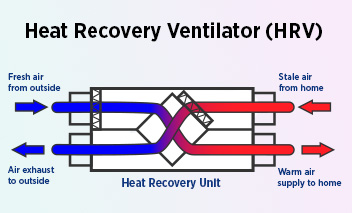Exploring the Conveniences of Heat Recovery Ventilation for Power Performance in Houses
Heat Recovery Ventilation (HRV) systems use house owners a useful method to enhancing energy performance. By redeeming warm from outgoing air, these systems can considerably lower cooling and heating costs. In addition, they give a stable supply of fresh air, enhancing indoor air top quality and convenience levels. As home owners take into consideration lasting choices, understanding the subtleties of HRV systems ends up being increasingly vital. What variables should one assess prior to making such an investment?
Understanding Heat Recovery Ventilation Solutions

Just How HRV Improves Indoor Air Quality

Energy Financial Savings: The Economic Benefits of HRV
Maximizing energy performance, heat recovery ventilation (HRV) systems use significant monetary benefits for property owners. By recuperating and recycling warmth from exhaust air, HRVs significantly minimize heating and cooling expenses. This innovation can bring about energy cost savings of as much as 30%, depending on climate and use patterns. Home owners often notice reduced energy expenses soon after installment, making HRVs Click This Link an economically smart investment over time. Additionally, many regions provide incentives or discounts for energy-efficient upgrades, additionally improving the financial allure. As energy prices proceed to increase, the cost-effectiveness of HRVs ends up being increasingly clear. On the whole, the unification of HRV systems not only promotes power effectiveness but additionally adds to lasting economic savings for homes.
The Ecological Impact of Heat Recovery Ventilation
A considerable ecological benefit of heat recovery ventilation (HRV) systems depends on their ability to minimize overall power consumption. By reclaiming heat from exhaust air and transferring it to inbound fresh air, HRV systems reduce the requirement for energy-intensive heating and cooling down techniques. This reduction in power demand adds to reduce greenhouse gas emissions, as much less fossil fuel is required to maintain comfy interior temperatures. Furthermore, HRV systems improve indoor air quality by efficiently trading stale air with fresh exterior air, reducing dependence on mechanical cooling systems that can harm the atmosphere. Generally, the implementation of HRV systems supports sustainable living methods and lines up with worldwide initiatives to combat climate change by promoting energy effectiveness in property setups.
Selecting the Right HRV System for Your Home
Exactly how can homeowners guarantee they pick the best heat recovery ventilation i was reading this (HRV) system for their requirements? They ought to evaluate their home's size and design, as these elements affect airflow requirements. Next off, reviewing the system's performance rankings is crucial, as greater scores suggest much better performance and power cost savings. Property owners must likewise take into consideration setup and maintenance costs, contrasting various brand names and models for worth. Additionally, it is necessary to evaluate noise degrees, as some systems operate even more quietly than others. Consulting with HVAC professionals can give customized recommendations based on details home conditions. Finally, examining user reviews and guarantees can aid in making a notified decision, ensuring that the picked HRV system properly boosts interior air top quality and energy performance.
Often Asked Questions

Exactly how Commonly Should I Clean or Keep My HRV System?
The regularity of cleansing or keeping a warm recovery ventilation (HRV) system typically depends on use and environmental factors. Normally, it is recommended to execute maintenance every six months to assure peak performance and air high quality.

Can HRV Systems Aid Decrease Moisture Levels Inside Your Home?
HRV systems can efficiently lower indoor moisture levels by exchanging stagnant, humid air with fresh, drier air additional resources from outdoors. HRV Heat Recovery Ventilation. This procedure aids keep a well balanced interior environment, improving convenience and protecting against moisture-related issues
What Is the Life expectancy of a Regular HRV System?
The life-span of a normal heat recovery ventilation (HRV) system differs, typically lasting in between 10 to 15 years. Normal upkeep can extend its effectiveness and functional life, making certain peak performance throughout its usage period.
Are There Any Kind Of Sound Worry About HRV Systems?
Noise concerns with HRV systems can arise, particularly from fan operation. Lots of contemporary units are developed to lessen sound levels, ensuring they operate silently while preserving efficiency, which addresses potential disturbances in living environments.
Can I Install an HRV System Myself, or Do I Need an Expert?
The private contemplated whether to install the heat recovery ventilation (HRV) system directly or employ an expert. Typically, while DIY installation is feasible, experience warranties appropriate capability and compliance with regional building ordinance, boosting system efficiency.